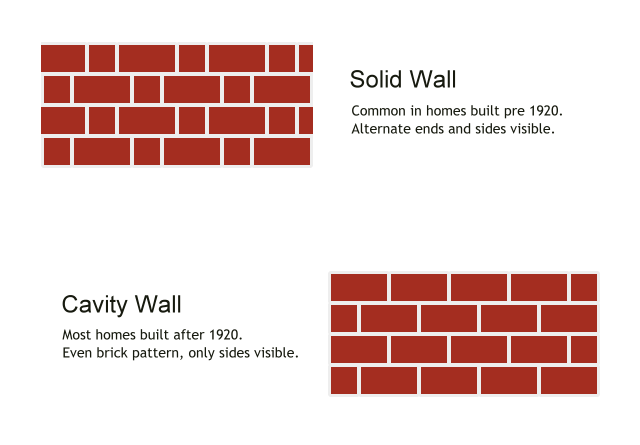More than a third of heat loss from an uninsulated home occurs through the walls, so cavity wall insulation should be high on the list of priorities for any householder with a suitable home. With some funding available to reduce the cost, it is one of the most economically attractive methods of insulating your home.
Is your home suitable for cavity wall insulation?
To benefit from cavity wall insulation, you will need to have a cavity in the walls of your home. This means a space in between the external and internal wall skins, which was originally constructed for protection from penetrating rain.
Most homes built from 1920 onwards will have been constructed with cavities in the wall, but you can check yourself to see if your home is suitable. Cavity walls have a regular brick pattern with all the long sides of the bricks showing, whereas solid walls alternate the orientation of the bricks in a thick-thin pattern.

Very modern homes, constructed since around 1999, may have been built with cavity wall insulation already in place. If you are unsure as to whether your walls are filled, an installer will be able to check with a small drill hole in the mortar between the bricks and a boroscope.
Concerns about cavity wall insulation
Some concerns have been raised in the past about cavity walls causing damp. However, in most applications as long as the insulation is applied correctly it is highly unlikely damp will occur. All cavity wall installations completed by a registered installer will be subject to a 25 year CIGA guarantee, providing protection for you for the long term future of your home.
A handful of homes will not be suitable for cavity wall insulation, particularly if they are in an exposed location where the rain drives against the exterior wall. Your installer should be able to recognise if damp is a risk and should not go ahead with the installation if they feel your home is unsuitable.
Which? have created a useful webpage and video about wind driven rain and damp problems. You can view this information here.
How is it installed?
Cavity wall insulation is not a DIY job. You should seek out a CIGA registered installer to carry out the work on your home. The installation will involve drilling a number of holes, roughly one every square metre, in the mortar between the bricks. Insulation material is them blown into the cavity until the whole wall is filled. It normally takes around two hours to install, but this will depend on the size of your home and the ease of access to exterior walls.
The materials used will vary from one installer to another, so be sure to ask what your options are before agreeing to the work. Commonly used materials include mineral wool, polystyrene beads and foam.
How much will it cost?
Some householders will be eligible for free or heavily discounted wall insulation under the Energy Company Obligations (ECO) scheme. The eligibility of your installation for ECO funding will depend on where you live, the complexity of the installation and whether you receive any benefits.
If you are not eligible under ECO you will need to pay for the installation yourself. A typical installation costs around £450 – £500, and you could consider applying for a Green Deal loan to help fund the work. In addition to the installation cost, there may be other costs to consider.
These include:
- Scaffolding: If you have a conservatory or are very close to a main road you may need to hire scaffolding to give the installers access
- Cherry picker: In some rare instances, a cherry picker may be required to access very high walls
- Decoration: Normally the installer will fill the drill holes with a similarly coloured mortar to the existing material. However, if you have a rendered, painted or pebbledashed wall, it can be impossible to truly hide the scars of a cavity wall fill. In this situation you might want to budget for a redecoration of the house too.
How much will you save?
A typical installation will save the householder around £140 per year and 560g of CO2. Bigger homes and detached properties could save up to £250 each year and over 1000g of CO2. Even at the lower end of this scale, the savings will pay back the cost of installing your insulation within around 4 years, giving cavity wall one of the shortest payback periods out of all energy efficiency measures.


